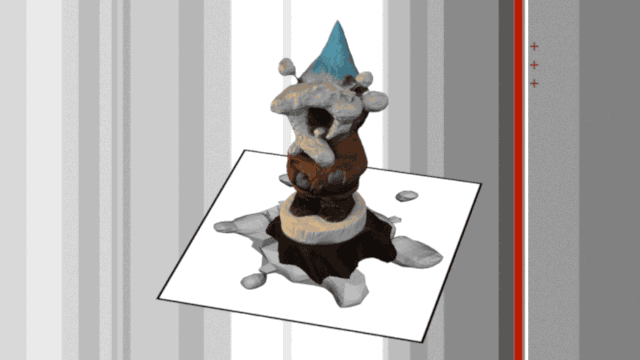Manifest data kit index
Manifest Data: A Kit to Create Personal Digital Data-Based Sculptures
Duke University Speculative Sensation (S-1) Lab
Duke University
 Material Intervention: Data Gnomes
Material Intervention: Data Gnomes
Karin Denson and Shane Denson
Manifest Data is a project about reclaiming "our" data from corporate cooptation (and/or making it our own in the first place), about contesting the exploitation of our digital labor (which may be of a cognitive, affective, or even playful sort), and about creating something of personal or collective value that would ideally be immune to such alienation.
In sum, our goal in this iteration of the project was to counter, in a way that is both symbolic and material, the expropriation of value from the data we produce. We strove to meet this goal through a series of translations between the digital and the physical — through a multi-stage process of sculpting and resculpting data into what we call a "data gnome." Basically, the data gnome is a garden gnome that is constructed in such a way as to integrate data from personal Internet usage — data gleaned through the use of the "benevolent spyware" coded by Luke Caldwell for Manifest Data — thus providing a sculptural embodiment of one's own online profile. The figure alternately occupies physical, virtual, and augmented spaces, all of which are increasingly subject to scrutiny, surveillance, and logging from a variety of state and commercial interests. As a popular mythological figure in Western folklore, it can stand as a sort of talismanic guardian of one's activities in these various spaces.
Makerbot and Marketing Gnomes
But why garden gnomes, of all things?
The answer to this question involves a somewhat complicated story, but it starts by recognizing the use to which a company like Makerbot has put the gnome in their marketing and demonstrations of 3D scanning and printing technologies.

Our data gnomes have to be seen against this background, and the question "why garden gnomes?" has to be directed first at such commercial-technological interests. Why would Makerbot — a company which has its roots in making open-source hardware but has since moved on to a closed, proprietary model — appropriate the garden gnome as a symbol for its technologies? Why, more generally, did data take the form of the gnome?
Considering the tone of many contemporary discourses championing the "revolutionary" changes heralded by 3D printing, which are seen to upset hitherto immutable boundaries of real and simulated (imaginary or computed) spaces, this question might be seen to have quasi-theological overtones, as a sort of digital correlate to debates over the correct interpretation of "transubstantiation" — over the real or imagined transformation from bread to body, blood to wine, or from digitally inscribed information to physically embodied object. St. Anselm's related Christological question, Cur deus homo? — "Why did God become man?" — becomes, in our digital, secular version, Cur data gnomo?.

In the case of Makerbot and their marketing campaign, the gnome is clearly positioned as a weirdly hip (in a geeky sort of way) non-conformist figure — and this is certainly telling with regard to Makerbot's target audience/perceived user-base. But there is a yet greater significance in the company's playful appeal to the gnome to illustrate a transformation of the virtual/physical threshold. To see what else is at stake in this appeal, it is helpful to recall the strange ontology of the traditional (read: bourgeois/conformist) garden gnome: these Old-World decorative figures embody a benign, sylvan spirit that is ready to help tend their masters' gardens while they sleep. The gnomes thus embody nature, but they labor at the service of culture (agriculture, horticulture, and the bourgeois "cultivation" of the garden, which is precisely non-nature); and their labor, significantly, is "free" (i.e. unpaid — a capitalist's dream!). Any association with nature is therefore illusory; the garden gnome is in fact a product of industrialization — and a perfect embodiment of the seriality that came to characterize production with the industrial revolution.
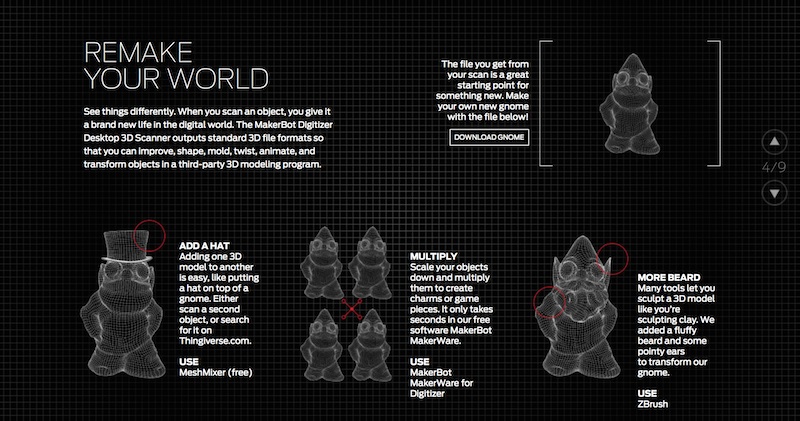
The particular function or appeal of the garden gnome for a company like Makerbot is to demonstrate the liberating potential of 3D printing, which to a certain extent takes the means of industrialized production out of capitalists' hands and places them back in the hands of artisans (or "makers"). The garden gnome makes visible the easy reproduction, manipulation, and transformation of physical objects, when mediated by the digital. And crucially, these objects are also positioned as infinitely shareable across digital networks.
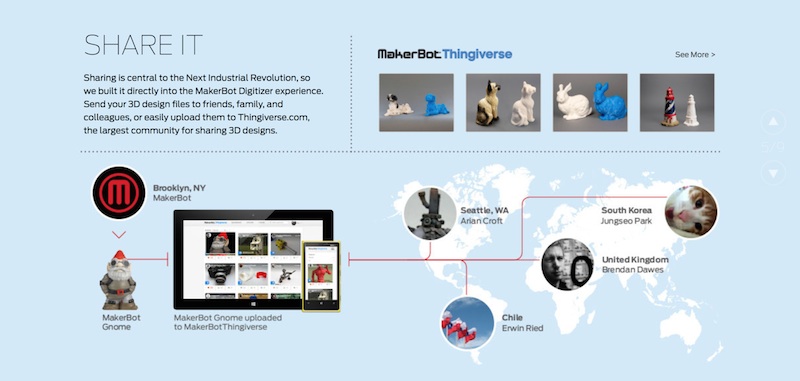
But the liberating narrative that Makerbot advances is problematic. We have no doubt that "shareability" is a positive thing for many of the artists and makers involved in the 3D printing scene. But a company like Makerbot still stands to profit from the creative labor of these people in a way that they themselves may not: in other words, participation in the Thingiverse network, like much of so-called "participatory culture," benefits corporate interests that continue to exploit a surplus, so that the democratizing effects of these technologies cannot be the whole story. The gnomes may have been liberated from the tyrannies of "nature" and of mass production, but they still serve the capitalist dream of free labor!
To be clear, we are by no means enemies of Makerbot. Far from it. For the technologies they produce, including the participatory networks that serve both to facilitate exchange among users and to promote and increase profits for the company, do indeed offer genuinely empowering potentials for some users. We are interested precisely in leveraging this ambivalent space of affordance and constraint, which we see as a fertile ground for an aesthetic intervention that is political without being simply oppositional.
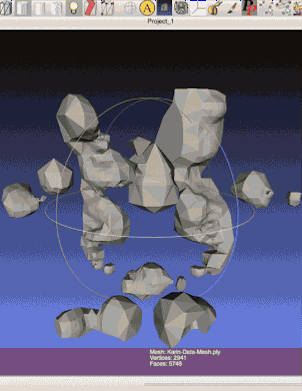
In any case, against a facile neo-cyber-Marxian dictum that "all that's solid melts into zeroes and ones," our data gnomes, which in their initial incarnation are hand-sculpted in concrete by Karin Denson, complicate the easy seriality and reproducibility that Makerbot emphasizes, confronting it with something more substantial and, well, concrete. The data gnome involves a whole series of mediations or translations between the digital and the physical, starting with the interpretation of a virtual 3D object (mapped in MeshLab using data collected by Luke Caldwell's code), the subsequent sculpting of this vision into physical media, and its gradual assumption of form and color. Luke's code gives form to the interface, while Karin's sculpture turns the gnome's physical face into a "data-face" (as our twelve-year-old son has called it).
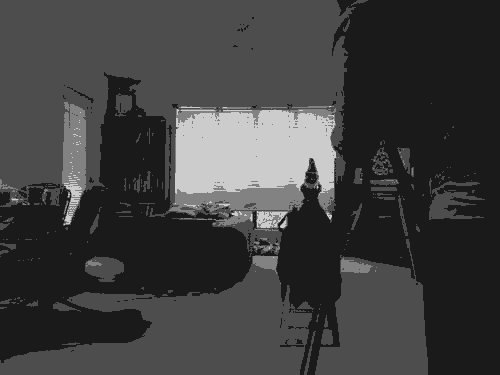

And then we reverse the process: with photogrammetric techniques, we scan the physical gnome back into the realm of the digital, reconstituting it as a 3D object and making it available for augmented reality applications. Having thus acquired the gnome as a digital 3D object, the concrete object is translated back into a serially reproducible thing, but one that nevertheless retains a sculptural density and specificity in the environment.
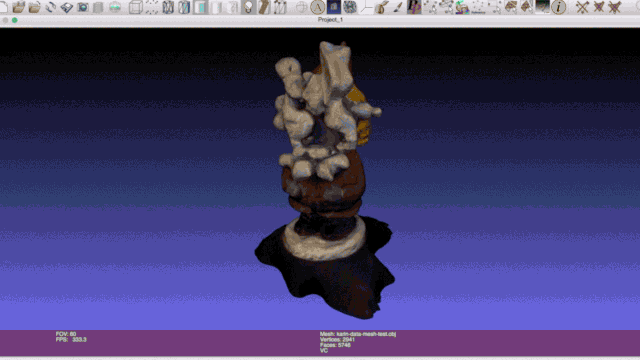
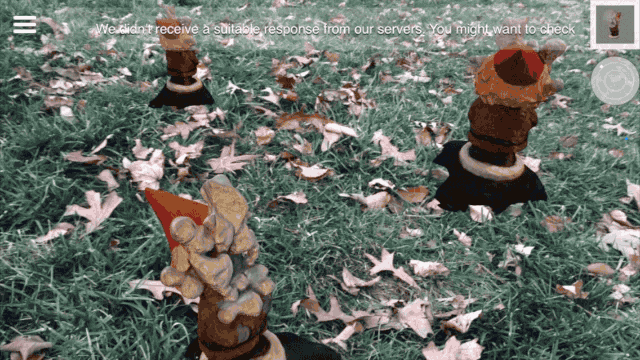
These characteristics stand out most forcefully when the re-digitized gnomes are placed back into the physical environment with the help of augmented reality programs/infrastructures such as Layar (which facilitates the "planting" of geolocated versions that are made accessible through apps on GPS-equipped smartphones) or Junaio (which is especially good at recognizing 2D images that are then AR-enhanced with 3D data gnomes).

In the course of the various translations between physical, virtual, and augmented spaces, we found ourselves playing with these creatures, chasing them around the woods near our house, following them into spaces indoors and out — and witnessing the way they re-enchanted mundane and taken-for-granted places. In the process, the gnomes slowly acquired something of a talisman-like character, and a very personal mythology began to take shape around them. We began thinking of them as personal guardians of the interface between the physical and the digital, as creatures that could ward off the bad spirits of digital capital and preserve us from the forces of cooptation and exploitation.
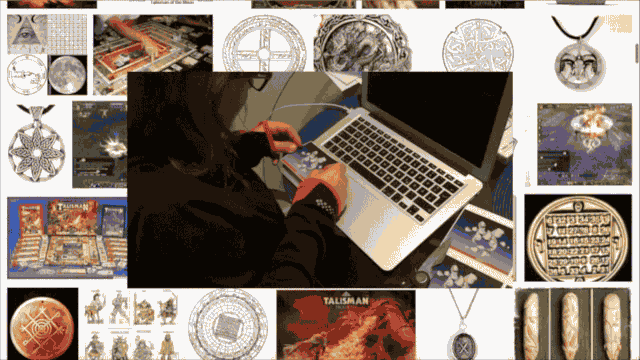

So we placed them wherever these interfaces took place: all the places we work and interact with online communities, the sites of our digital labor. Visible only to us, the gnomes, which are in an important sense "portraits" of our own activity (as Manifest Data collaborator Max Symuleski has put it), stand guard and protect our interfacings like some crazy digital patron saints.
